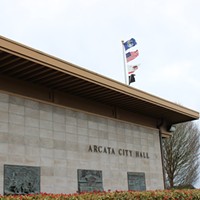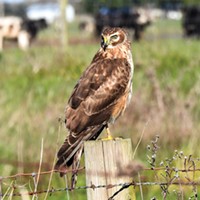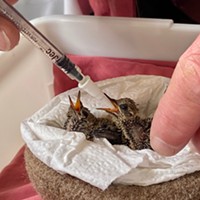Monday, February 8, 2021
For the Birds, It's Time to Hit Pause on Major Trimming, Vegetation Removal
Posted By Kimberly Wear @kimberly_wear on Mon, Feb 8, 2021 at 6:25 AM
For the birds, the city of Arcata is reminding residents to avoid tree trimming or other major yardwork that disturbs or removes vegetation as nesting season arrives.
According to a news release, the first of the month marked the start of the early nesting season, when hummingbirds and birds of prey, including kites, hawks, owls and eagles, begin bedding down, followed by most others around mid-April through the summer months.
“Major disturbances to vegetation, especially trees, should be avoided unless there is a thorough check for these nesting birds prior to beginning work,” the city’s release states. “Weeding and mowing lawns are acceptable activities during this time.”
To determine whether nesting is taking place, the city offers these tips:
The city recommends limiting any tree removal activity to the period of Sept. 1 to Jan. 31 and notes that “a tree removal permit may be required for trees of 16 inches or more in diameter at chest height.”
Find the full city release below:
According to a news release, the first of the month marked the start of the early nesting season, when hummingbirds and birds of prey, including kites, hawks, owls and eagles, begin bedding down, followed by most others around mid-April through the summer months.
“Major disturbances to vegetation, especially trees, should be avoided unless there is a thorough check for these nesting birds prior to beginning work,” the city’s release states. “Weeding and mowing lawns are acceptable activities during this time.”
To determine whether nesting is taking place, the city offers these tips:
To detect bird nests, watch bird behavior. If a bird is carrying nest material or food to the same place in a patch of vegetation more than once, there is likely a nest in the area. Also, look for concentrations of white droppings on the ground, then check the trees or vegetation above the droppings for a nest. Actual nest structures are typically well-concealed and may not be seen if they are located in dense vegetation.
If a bird is observed repeatedly visiting a nest or suspected nest site, building or sitting on a nest, it is considered “active” with eggs or nestlings. If an active nest is found prior to work, avoid work in the area until the young have fledged. A 50-foot no-work buffer should be applied for songbirds and a 500-foot no-work buffer should be applied for raptors.
The city recommends limiting any tree removal activity to the period of Sept. 1 to Jan. 31 and notes that “a tree removal permit may be required for trees of 16 inches or more in diameter at chest height.”
Find the full city release below:
The City of Arcata would like to remind the community that early bird nesting season has begun. Humboldt Bay and its surrounding areas are home to a wide variety of bird species, so it is especially important that all community members check for active nests before trimming or removing vegetation during nesting season.
The federal Migratory Bird Treaty Act makes it illegal to pursue, hunt, capture, kill or transport any migratory bird or the parts, nests or eggs of such a bird except under the terms of a valid federal permit.
Contractors are advised to have a qualified biologist conduct nesting bird surveys prior to beginning any project that requires vegetation removal, and the Environmental Services Department has some helpful guidelines for all members of the community to follow:
Early bird nesting season lasts from Monday, February 1 to Friday, April 15. At this time, hummingbirds and birds of prey including hawks, owls, kites, eagles, vultures and falcons begin to nest. Major disturbances to vegetation, especially trees, should be avoided unless there is a thorough check for these nesting birds prior to beginning work. Weeding and mowing lawns are acceptable activities during this time.
Primary nesting season for most birds will take place Friday, April 15 until Tuesday, August 31. Disturbances to vegetation should be avoided during this time unless a thorough check for nesting birds is completed prior to beginning work. Weeding and mowing lawns are still acceptable activities during this time.
Wednesday, September 1 through Monday, January 31, 2022, is the best time to plan for tree removal, invasive plant species management, mowing and brush clearing. Please note that a tree removal permit may be required for trees of 16 inches or more in diameter at chest height.
To detect bird nests, watch bird behavior. If a bird is carrying nest material or food to the same place in a patch of vegetation more than once, there is likely a nest in the area. Also, look for concentrations of white droppings on the ground, then check the trees or vegetation above the droppings for a nest. Actual nest structures are typically well-concealed and may not be seen if they are located in dense vegetation.
If a bird is observed repeatedly visiting a nest or suspected nest site, building or sitting on a nest, it is considered “active” with eggs or nestlings. If an active nest is found prior to work, avoid work in the area until the young have fledged. A 50-foot no-work buffer should be applied for songbirds and a 500-foot no-work buffer should be applied for raptors.
For more information on vegetation management, bird safety and construction guidelines, click here or call the Environmental Services Department at 707-822-8184.
Speaking of...
-

Judge Takes Earth Flag Case Under Submission
Jan 19, 2024 -

Look! Up in the Sky!
Nov 16, 2023 -

A Bird in Hand
Aug 17, 2023 - More »
Comments
Showing 1-1 of 1
Readers also liked…
more from the author
-
Eureka Man Killed in SoHum Crash
- Jul 1, 2024
-
Caltrans Selects Tunnel Option for Last Chance Grade
- Jun 18, 2024
-
Kyle Steven Wear: 1970 —2024
- Jun 16, 2024
- More »
































